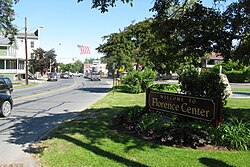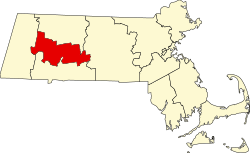Early industry
Factory villages along the Mill River were producing cotton goods, silk, wool, thread, buttons, wood items for domestic use, furniture, and leather by 1840. [7]
Samuel Whitmarsh moved to Northampton in 1829 and was convinced that silk production would be a promising business venture. [7] He planted 25 acres (10 ha) of mulberry trees in Florence in order to raise silkworms. Whitmarsh's company, the Northampton Silk Company, began manufacturing silk thread in 1837. [7] Due to economic recession and losing critical investors, Whitmarsh sold this business which was later purchased by the Northampton Association of Education and Industry. [7] [6] Silk production would go on to be an important product in the Florence economy.
Notable residents
Samuel L. Hill moved to Florence in 1841 to be one of the founders of the NAEI. Born in Smithfield, Rhode Island to Quaker parents, Hill had trained as a carpenter and was the superintendent of a cotton textile factory in Willimantic, Connecticut. [12] A member of the anti-slavery movement, Hill's home at 31-35 Maple Street in Florence served as a stop for the Underground Railroad. After the NAEI dissolved, Hill took over the factory and ran it as the Nonotuck Silk Company and was also a partner in other local factories. Hill and others founded the Free Congregational Society in 1863 and supported the construction of Cosmian Hall. A supporter of education, Hill organized the Florence Kindergarten in 1876. Upon his death in 1882, he left an endowment to support the kindergarten which later became the Hill Institute. [13] [12]
Sojourner Truth, a former slave from the Hudson Valley in New York, moved to Florence in 1843 to become a member of the NAEI community. [11] After the community dissolved in 1846, she bought a house on Park Street where she lived until 1857. In Florence, Truth gave her first public lecture and developed her craft as a public speaker. She met Olive Gilbert within the NAEI community who would transcribe Narrative of Sojourner Truth: A Northern Slave. [14] NAEI introduced Truth to William Lloyd Garrison who connected her to the printer of The Liberator and Frederick Douglass's slave narrative. [15] Truth published her narrative in 1850 on credit with the same publisher. [16] A memorial statue was erected in her honor in Florence in 2002.
David Ruggles was an African American abolitionist, journalist, business owner, and a practitioner of hydropathy. [17] He was one of the founders of the New York Committee of Vigilance, an organization dedicated to protecting the rights and safety of African Americans in the 1830s. [18] By the early 1840s, Ruggles was struggling due to falling out with the New York Committee of Vigilance, the death of his father, protests in New England over segregated seating on trains, and his overall declining health rendered him almost blind. [19] [20] On learning of his health and financial struggles, Lydia Maria Child and others arranged for him to join the NAEI community. As a member of the community, he sought out hydropathic treatments for his ailments under Dr. Robert Wesselhoeft in Cambridge. Ruggles began practicing hydropathy himself, and in 1845 he established a water cure hospital on the Mill River. Ruggles died in Florence in 1849 at the age of 39.
Charles Munde emigrated from Germany. He became familiar with the water cure methods of Vincent Priessnitz around 1836. [21] After the death of David Ruggles in 1849, Munde picked up where Ruggles left off and opened the Florence Water Cure, also called the Munde Water Cure. [22]


